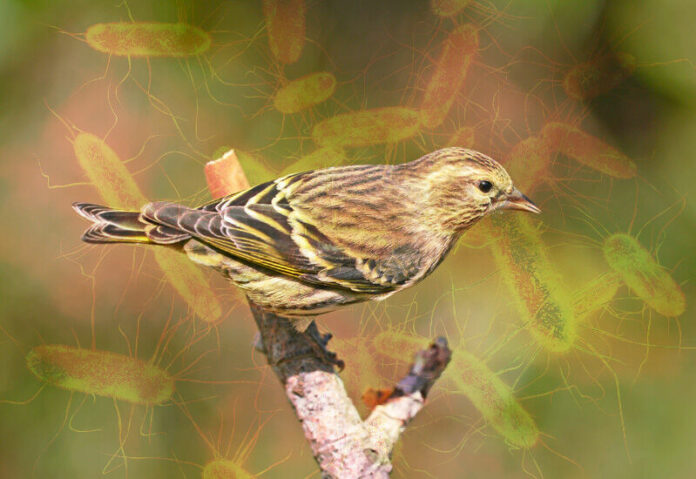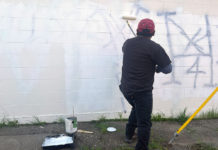While humans struggle with COVID-19, a migratory bird faces a different epidemic
On Feb. 8, California Fish & Game took the unusual step of asking residents of Sonoma County and several other counties to take down their bird feeders and bring in their bird baths because of an outbreak of salmonellosis among an innocuous little brown bird called the pine siskin.
Veronica Bowers of Native Songbird Care & Conservation in Sebastopol said the outbreak actually began in fall, but that it — like another outbreak we could name — has grown over the winter.
Bowers said that Sonoma County has its own very small population of pine siskins, but that the ones that are getting ill are pine siskins that have migrated south in the thousands from the boreal forests of Canada.
They’re coming in larger numbers than usual this year, a phenomenon called an irruption, and that’s often accompanied, she said, by a salmonellosis outbreak.
The pine siskins aren’t bringing the disease. Rather they’re picking it up from local birds when they congregate at bird feeders or when they use improperly-cleaned bird baths.
“There are a lot of wild birds who are carriers of it, and they just remain asymptomatic, but they’re shedding it by pooping at bird feeders and bird baths,” Bowers said. “There’s probably some immunity among our population of songbirds that are frequenting bird feeders here in California, but for whatever reason that population of pine siskins that come down from further north are just highly susceptible to the salmonella bacteria.”
Typical signs of the illness are lethargy, puffy or fluffed up appearance, and occasionally swollen or irritated eyes. The disease is usually fatal. The last serious outbreak happened in 2014-2015, Bowers said.
Help comes too late
Bowers said her organization has received many calls from residents who’ve found sick or dying birds on their property.
“Starting in November, it was kind of steady — maybe one or two birds a week — and then by end of December we were getting several of these little guys a week, and some were arriving DOA (dead on arrival). Then in January we were just getting flat out reports of people calling saying, ‘We’ve got dead birds in our yard, and they look like this.’”
When someone brings in an ill bird to the songbird hospital, it’s quarantined from other birds.
“We have many bio-security protocols in place at all times, regardless of salmonellosis outbreaks, that protect our patients from exposure to pathogens,” she said. “Lots and lots of disinfecting hands, surfaces, housing, dishes, syringes, door handles, you name it. And we are also extremely careful in between tending one patient to the next to ensure that all possibilities of cross-contamination and exposure have been eliminated.”
“It’s a good thing I was raised by a germophobic mother — bio-security is my middle name!” she joked.
Most of the birds that arrive at the bird hospital with salmonellosis don’t survive.
“Unfortunately, by the time the birds are ill enough to be captured, they are in a critical condition,” Bowers said. “Most arrive grossly underweight, and the disease is very advanced. They often expire within hours of admission. The bacteria attacks the entire G.I. system. The tissue becomes inflamed and develops ulcerations from the throat all the way down to the intestines.”
She said they have successfully treated and released just three of the dozens of pine siskins that they have received since the end of November. Those three had only minor symptoms of the disease.
A widening epidemic
But pine siskins aren’t the only victims of the illness. Once it gets started, a salmonellosis epidemic can spread to local birds as well, particularly goldfinches and other finch species.
“We’ve received several goldfinches over the last couple weeks sick with salmonellosis,” Bowers said. “I expect that we will start seeing house finches affected by it very soon.”
Although humans can contract salmonella, they generally don’t pick it up from wild birds. Generally, people develop salmonellosis from eating food contaminated with salmonella.
“They would have to ingest a lot of bird poop to become clinically ill with the bacteria,” Bowers said.
She does say, however, that if you find a dead bird in your yard, you should pick it up with a cloth or glove and be sure to wash your hands thoroughly afterwards.
Bowers said the salmonellosis epidemic has several similarities to COVID-19 — not just in its timing but in the fact that it can be spread by asymptomatic carriers and is particularly likely to spread in places where its would-be victims congregate — which, in the case of birds, is around bird feeders and bird baths.
The problem with bird feeders and bird baths
Explaining the problem with bird feeders, Bowers said, “The birds just sit there and eat and defecate, and defecate and eat. Feeding stations are a direct source of transmission of the bacteria to these guys. Then once they become infected, they spread it.”
Bird baths, she said, are just as bad. “The reason we say ‘Remove bird baths’ is because they’re a shallow basin of stagnant water. If that water isn’t being changed out every single time a bird comes along and drinks and poops in it, then you’re just allowing a reservoir of bacteria to accumulate.”
Because many bird baths are too heavy to move, she recommends emptying them out and covering them.
She said water features with moving water, like ponds or water fountains where the water is being oxygenated, aren’t as likely to spread the disease.
Originally Bowers said her organization had recommended removing bird feeders and bird baths for just a few weeks, until the sick birds died off, but then, she said “Fish & Game issued the alert, asking everybody just please take those items down for the rest of the winter and don’t put them back up until spring, when the pine siskins start heading north.”
That happens around the end of March, she said.
Bird feeders are for people, not for birds
Bowers said people are often worried about taking their bird feeders down because they think wild birds depend on them for food.
“The number one concern that we hear from our community when we have this discussion with them is ‘Where will they find food?’” Bowers said. “That’s a valid concern, but these guys know where to find food. All of our birds and wildlife do. They’ve been finding food successfully in the wild on their own before bird feeders ever came along.”
“We need to be really clear about the fact that bird feeders were invented for human enjoyment,” Bowers said. “They are not a mechanism to help birds survive.”
She said it’s a hard conversation to have with people, especially during the COVID-19 pandemic.
“We’ve got people who are dutifully staying home and sheltering in place, and they’ve started feeding birds because it brings a lot of joy into their daily lives to see these little guys. Then to ask them to take the feeder down, you know, it makes them sad.”
“I certainly appreciate that,” she said, “But we know what the problem is with these little birds, and we know the solution is to remove the feeders and the bird baths.”
Townsy is a recently-launched community app, offering local news, online shopping at local stores, a local event guide, local volunteer and job boards and more.
Sonoma West Publishers is partnering with Townsy to make news from Sonoma West Times & News more accessible to the Sebastopol community.








